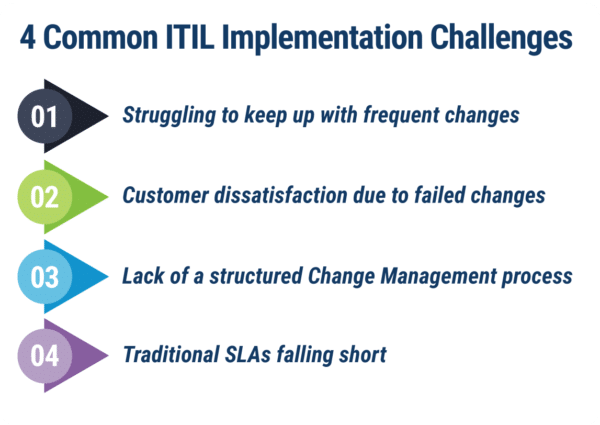Change Management SLA: Unveiling the Impact in ITIL
Introduction
Things You Will Learn in This Article:
- Understanding the Significance of Change Management SLA
- The Role of ITIL in Change Management SLA
- Benefits of Aligning Change Management with ITIL
- Crafting Your Change Management SLA
You’ve landed in the right place if you’re currently tired of experiencing the chaos associated with the process of planning, implementing, and guiding your organizational changes effectively.
If you’re overwhelmed by an influx of service requests and you’re struggling to meet your company’s IT service delivery promises, then you may be happy to learn the solution may be as simple as a Change Management SLA.
As you are most likely aware, Change Management is a critical part of your IT Service Management (ITSM), and getting it right can be significant for your organization. But managing change effectively isn’t easy, especially when you’re dealing with complex IT environments and high customer expectations.
In this article, we’ll dive deep into the world of Change Management SLA in ITIL (Information Technology Infrastructure Library) and how it can transform your IT service delivery. These changes could be akin to upgrading your internal IT systems or ensuring your company’s software is always up to date, addressing both internal and customer-related issues.
Understanding ITIL in the Change Management SLA Landscape
Imagine Change Management SLA as a set of rules that help businesses make important changes to their IT systems without causing chaos.
Now, ITIL, which is like the superhero of IT management, plays a crucial role here. It’s like the wise wizard guiding the IT team through the world of changes. ITIL provides a set of best practices that make sure these changes happen smoothly and without any hiccups.
In the Change Management SLA landscape, ITIL will give your company a playbook on how to handle changes – when to make them, how to plan them, and how to make sure everything still works perfectly afterward.
So, in simple terms, ITIL manages changes in the IT world. It ensures that when changes happen, you won’t disrupt the peace and harmony of the IT ecosystem. Instead, you’ll bring improvements and upgrades that everyone in your organization can enjoy.
4 Common ITIL Implementation Challenges
1. Struggling to keep up with frequent changes: IT changes happen quickly and they happen frequently. Keeping track of them and ensuring they don’t disrupt your services can be daunting.
2. Customer dissatisfaction due to failed changes: When changes go wrong, it’s not just your IT team that suffers. Customer satisfaction takes a hit, and your business may lose credibility.
3. Lack of a structured Change Management process: Without a well-defined process, Change Management can become chaotic. This leads to miscommunication, bottlenecks, and missed deadlines.
4. Traditional SLAs falling short: Traditional Service Level Agreements (SLAs) often don’t address the unique challenges of change management. They’re not designed to manage the complexities of changes in IT environments.
But here’s the good news. Change Management SLA in ITIL can be your model of hope in the tumultuous sea of IT changes. It’s a framework that provides structure, transparency, and accountability to your Change Management process.

Benefits of Aligning Change Management with ITIL
- Enhanced Operational Efficiency: By following ITIL principles, your Change Management process becomes smoother and more organized, saving time and resources.
- Reduced Downtime: ITIL helps you plan changes more effectively, minimizing disruptions and ensuring that your systems are up and running quickly after changes.
- Heightened Customer Satisfaction: With fewer disruptions and faster resolutions, your customers will experience improved service quality, leading to greater satisfaction.
Crafting Your Change Management SLA
When crafting your Change Management SLA, you’ll want to leverage a variety of resources to ensure it’s comprehensive, effective, and tailored to your organization’s needs. Here are some valuable resources to consider:
- ITIL Framework: Start by referring to the official ITIL framework guides and publications. They provide a foundational understanding of ITIL principles, including how Change Management fits into the larger IT Service Management context.
- ITIL Training and Certification: Consider enrolling in ITIL training courses or encouraging your team members to do so. Certifications like ITIL Foundation can provide in-depth knowledge and practical insights.
- Change Management Software: Invest in Change Management software tools that are aligned with ITIL principles. These tools often come with templates and workflows that can facilitate the creation and implementation of your SLA.
- ITIL Practitioners and Consultants: If possible, consult with ITIL practitioners or experts who have experience in implementing Change Management SLAs. They can provide guidance, share best practices, and offer real-world insights.
- Industry Best Practices: Research and study industry-specific best practices related to Change Management. Industries like healthcare, finance, or manufacturing may have unique requirements that should be reflected in your SLA.
- SLA Templates: Look for SLA templates specific to Change Management. These templates can serve as a starting point and help ensure you cover all essential components in your SLA.
- Change Advisory Board (CAB): Collaborate with your organization’s CAB, which typically includes key stakeholders and experts. Their input can be invaluable in defining the SLA’s terms, especially regarding change approvals and risk assessments.
- Feedback from End Users: Gather feedback from end users and customers who will be impacted by the changes. Understanding their expectations and concerns can help you refine your SLA to meet their needs.
- SLA Examples: Study examples of Change Management SLAs from similar organizations or industries. While not a direct template, they can provide inspiration and ideas for structuring your SLA.
- Legal and Compliance Experts: Depending on your industry and region, consider consulting with legal and compliance experts to ensure your SLA adheres to relevant laws and regulations.
- Internal Documentation: Review your organization’s existing internal documentation, policies, and procedures related to Change Management. Ensure your SLA aligns with these documents and promotes consistency.
- Feedback Loops: Establish feedback loops within your organization to continuously improve the SLA. Regularly solicit input from stakeholders, assess the SLA’s performance, and make necessary adjustments.
Crafting an effective Change Management SLA is a meticulous process, but with the right resources and approach, you can create a powerful tool that enhances your organization’s Change Management efforts.
For more than two decades, Vivantio has been ready to revolutionize your IT service delivery. Dive into Change Management SLA in ITIL and harness the transformative power of ITIL principles. Elevate your Change Management process now! Contact our team today or register for a free demo to get started today.













